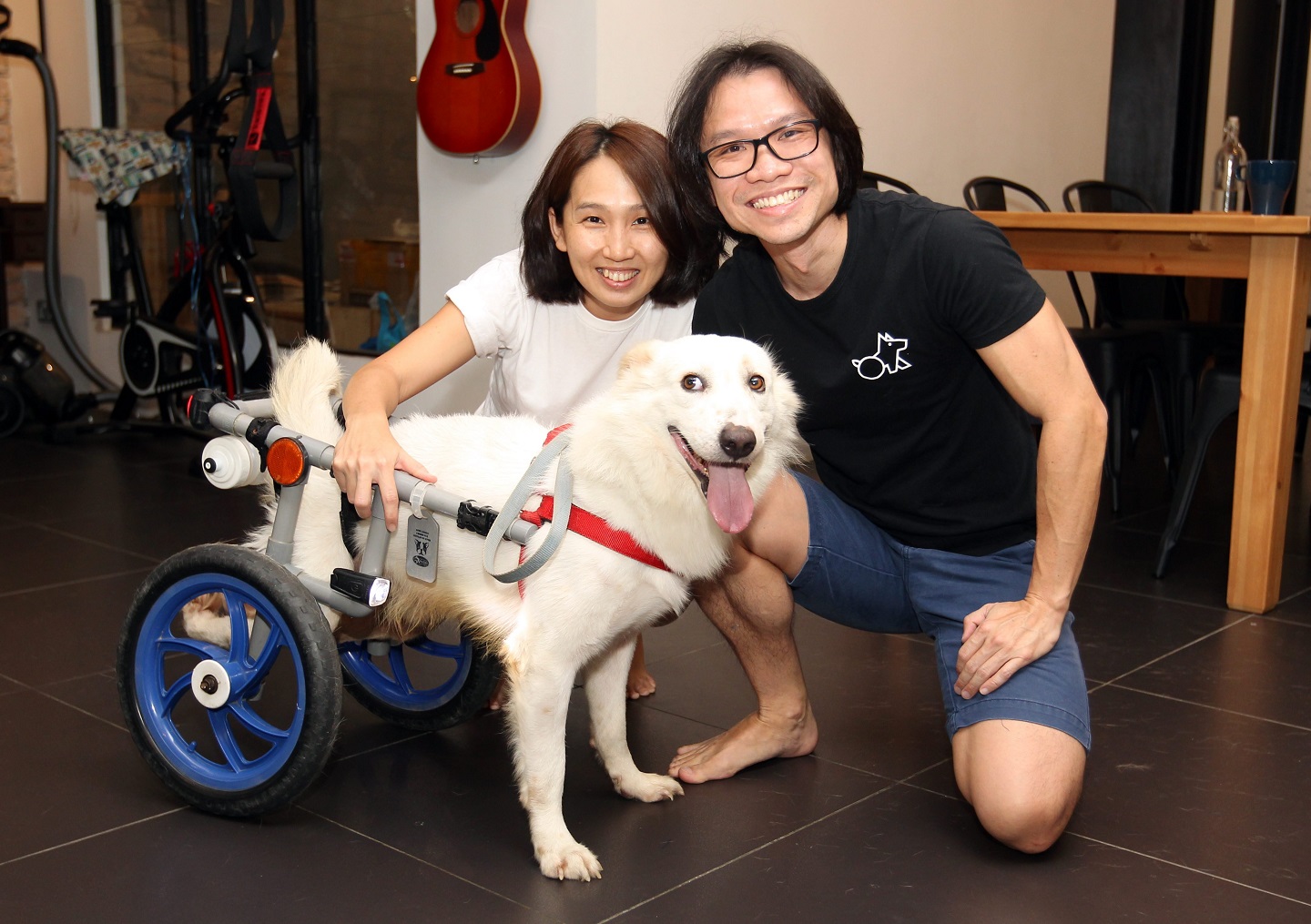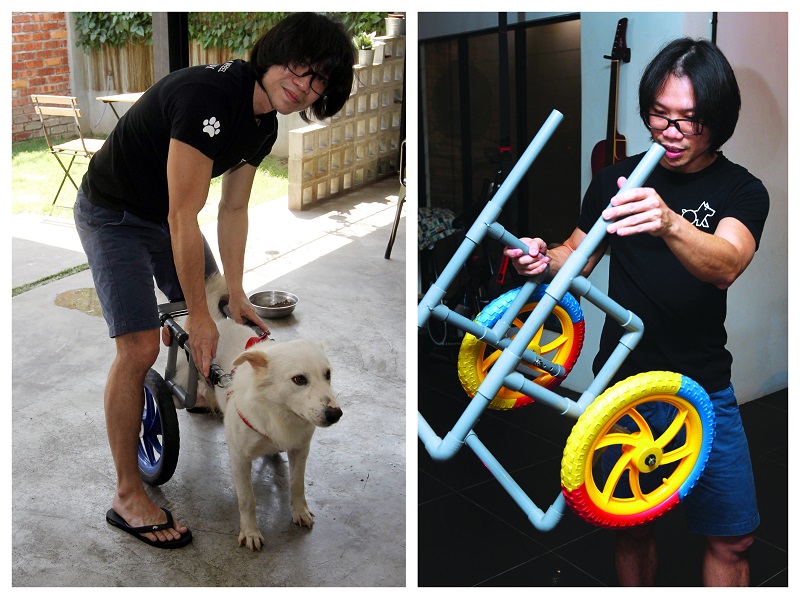
Founder of Dog Wheelchair Malaysia Wong Che Wey and his wife Cheng Yee Leng (Photo: Suhaimi Yusuf/The Edge)
Four legs good, two legs bad.” Frisky canines know that better than George Orwell’s power-hungry hogs as they cavort the way Nature intended. And if any of them, like Frosty, need help with mobility, Dog Wheelchair Malaysia founder Wong Che Wey is prepared to equip them with wheel power.
The loving mutt used to drag himself around after his hind legs were disabled in an accident. When his owner also hurt her legs last August, rescuers brought him to Wong and his wife Cheng Yee Leng, who are both interested in DIY projects.
Wong started looking for a dog wheelchair for Frosty but could only find aluminium models from the US, which cost RM1,000 to RM2,000 each. He decided to make one himself with PVC pipes, taking cues from YouTube videos initially.
“What you see and what you put the dog on are different because he will flip and tumble as he tries to adapt to the wheelchair. If he is excited, he will somersault,” says Wong, who came up with three designs before getting the balance right. Now Frosty, when harnessed to his wheels — affixed with safety reflectors and a water bottle — hardly breaks a sweat as he follows Wong on 5km romps around their Klang home. His severe skin problems, a result of abrasion and pee-soaked fur, have cleared, he has put on weight and is a picture of health.
Giving paralysed dogs another chance drives Wong’s endeavour. Shelters normally do not take in immobilised canines, which need special attention, so they end up being cared for by rescuers or are put to sleep, he says. Encouraged by Frosty’s transformation, he started building a few chairs for rescuers and posted them on Facebook. Soon, he learnt that many people were looking for such a product. To reach out to them, he and Cheng set up Dog Wheelchair, an online business, last December.

Their customised lightweight creations, available in three sizes, take into account a dog’s height, length and width. Wong cuts PVC pipes of varying thicknesses for the frame while Cheng tailors harnesses and straps from dog leashes, to attach the chair to the canine’s body so it does not swing up and down. They use children’s bicycle wheels, which add a colourful touch to the contraptions.
Ideally, owners should bring their pets to them for a fitting so they can make immediate adjustments, if needed, Wong says. Occasionally, there is some run-out despite their following measurements because accidents or deformity can affect a dog’s posture.
Hooked to their wheels, the creatures will have no problem standing for up to five hours, he adds. “They are actually standing with their front legs supporting half their body. If a dog is tired, he will kneel on his front legs. The straps can be changed — they are all general cable ties that don’t need any special fitting.”
Since last September, the couple has made about 70 wheelchairs for dogs, five for cats and one for a rabbit! “The chairs can last forever as the pipes are weatherproof and very durable.” Even if the rubber on the wheels wears out, it will not affect mobility because the animals are not running fast, says Wong, who makes “house calls” within the Klang Valley to fit a canine with a chair.
What you see and what you put the dog on are different because he will flip and tumble as he tries to adapt to the wheelchair. If he is excited, he will somersault
Frequent questions on how to fashion the chairs have prompted plans to teach pet owners to do it on their own. He does not worry about competition. “It’s okay because I do this part-time and don’t earn much,” says the technical manager for an automotive lubricant company. His products cost RM250 to RM350. “It’s better if more people make chairs for paralysed dogs so they won’t be put to sleep and can be adopted.”
Wong is also looking to take part in road shows where he can demonstrate how to make the chairs. “You can get all the stuff you need from a hardware shop. The hardest part is measuring the animal and getting the balance right.” Having overcome those obstacles through research and trial and error, he is confident others can do the same. He takes two hours to make a chair for each dog or an hour to fix one using a ready frame.
In June, he designed a T-shirt, Dog Wheelchair’s first merchandise, to get some funding. He builds the chairs free for animals adopted by rescuers or at shelters. “You see them having a hard time raising funds and getting donations, so I try to help,” says Wong, who has three other dogs besides Frosty, all picked up by freelance geo-physicist Cheng from the time they got to know each other nine years ago.
Passion and compassion may oil the wheels of their home-based business, but it is seeing maimed pets happily spinning around that gives them the most satisfaction. To put a spin on Old Major’s chant in Orwell’s Animal Farm, “two legs good, four legs better”.
This article first appeared on Aug 6, 2018 in The Edge Malaysia.


